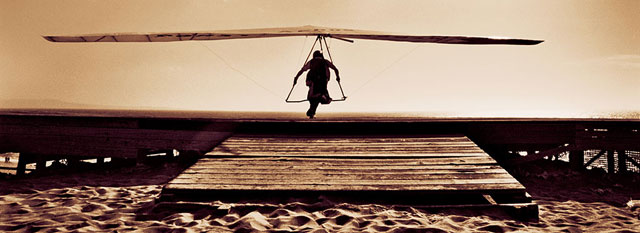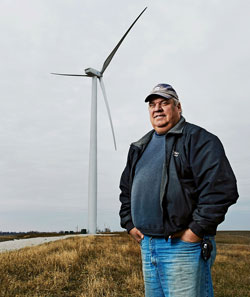sierraclub.org - sierra magazine - march/april 2013 - wind rush: anywhere it blows

Stephen Austin Welch
Through the ages, wind has filled our sails, lifted our wings, and thrilled our souls. Now, with rapid advances in turbine technology, it's propelling us into a world beyond fossil fuels. Wind already generates more than 10 percent of the electricity in five states; strip away the subsidies for all fuels, and it's the cheapest energy source we have. Feel that cool breeze? That's the clean-energy future, blowing in as we speak.
ANYWHERE IT BLOWS
Wind is no longer the energy source of the future. It's ready today.
By Edward Humes
 Randy Caviness, Iowa wind farmer | Photo by Dan Brouillette
Randy Caviness, Iowa wind farmer | Photo by Dan Brouillette
By late October, the gently rolling farmland of central Iowa is stripped bare, its fertile miles of cornfields shorn by harvesters and swept clean by the incessant prairie wind. "We just finished the harvest last night," Randy Caviness says as he gazes fondly at his fields, his weary face as stubbly as his 3,200 acres of corn and soy. "There's only one crop left."
He turns his old Ford pickup onto a narrow Adair County farm road, then brakes and points. "There it is. We harvest that crop every day, year-round."
A lone wind turbine dominates the landscape, a huge, gleaming, brilliantly white obelisk rising improbably from a drab flatland of browns and grays. It seems jarringly out of place and proportion, like a skyscraper amid mud huts. From base to blade tip, this 1.6-megawatt windmill stands 400 feet, taller than the Statue of Liberty's torch. If it were a building, it would be the third highest in the state. The three-bladed fan at its summit spans an area the size of a football field. Despite a stiff breeze, those massive blades, each as long as three New York City subway cars, seem to rotate lazily, but Caviness says that's just an optical illusion born of size and perspective—the blade tips reach speeds of 100 miles an hour.
"I'm amazed every time I see it," the 54-year-old farmer says. "That one turbine powers a whole town. And more."
Caviness is riding Iowa's wave of wind power development, which is upending old notions about renewable energy. The eight turbines of the community wind project he launched deliver 12.8 megawatts to local communities and rural utilities, enough juice to power 6,000 Iowa homes. They also generate healthy annual returns of up to 16 percent on the $12,000 to $50,000 individual investments from 180 local farmers. At four cents a kilowatt-hour, that's some of the cheapest electricity in the country, costing less than half of last year's national average for all electricity sources, coal and gas included. No wonder, then, that Caviness has been courted by the office of Iowa governor Terry Branstad, the state congressional delegation (including Tea Party firebrand Steve King), and the White House, all of them captivated by a project that positions wind power not as an expensive novelty or environmental altruism but as a profitable, practical source of electricity, jobs, and energy independence.
In a struggling national economy, the wind power industry currently supports an estimated 75,000 jobs.
"Everyone loves us," Caviness says. "Our turbines make electricity cheaper than they can buy it elsewhere. Obviously we need to do more of this—in the state and the rest of the country."
Such enticing economics are becoming the rule for new wind power projects. Caviness's experience has been replicated throughout Iowa, which had 5,100 megawatts of wind power online at the end of 2012—nearly 10 percent of the U.S. wind power total of 60 gigawatts (including projects under construction). Of the state's electricity-generating capacity, 20 percent is now wind-based. Were it a country, Iowa would be second only to perennial world wind leader Denmark, which generates 28 percent of its electricity from the breeze.
Iowa's wind industry is not limited to small independents like Caviness. The state's largest energy provider, Warren Buffett's MidAmerican Energy, leads the nation's utilities in wind power, which accounts for 31 percent of its generating capacity (up from zero percent in 2004). Company officials say that wind power has reduced MidAmerican's dependence on more costly coal and lowered its greenhouse gas emissions per megawatt by 18 percent—all while keeping Iowa's electric rates among the lowest in the country.
The combination of corporate investment, bipartisan support, fast-improving technology, robust state and federal subsidies, and, of course, strong winds has created a "wind renaissance" in Iowa over the past decade. Harold Prior, executive director of the Iowa Wind Energy Association, thinks it could serve as a national model. By 2010, Prior says, three turbine factories were operating in the state, 250 supplier and support businesses had set up shop, and community colleges were opening training centers for turbine technicians, who are in heavy demand worldwide and whose entry-level salaries can top $70,000. (See "Corporate Climbers," page 54.) Officials at Kirkwood Community College in Cedar Rapids, which has a wind lab with a gigantic working turbine nacelle and a towering windmill outside to help power the campus, say they can't churn out technicians fast enough.
In a tough national economy, the wind industry currently supports an estimated 75,000 jobs, about 7,000 of them in Iowa, according to the American Wind Energy Association. An estimated 12 gigawatts of wind capacity were installed nationwide in 2012 alone, more than any other energy source, coal and gas included.
A congressional push to kill wind tax incentives clipped those gains with layoffs and plant closures, despite a last-minute reprieve—even as new data suggest that wind power is rapidly becoming competitive with fossil fuels. (See "Wind's Close Call,".)
When the effects of subsidies that all energy industries receive are stripped away, wind power beats everything else—natural gas included.
"Wind has reached a critical mass here," says David Osterberg, head of the Iowa Policy Project and a former legislator who helped start the state's wind program in the 1980s. (Iowa was the first state to require power companies to provide a certain percentage of clean energy, years before California's better-known green energy mandate.) "It is finally all coming together."
For years, solar energy has been America's renewable star, drawing most of the headlines, the big government research dollars, and showy projects in the Mojave Desert. Yet on cornfields, in cow pastures, and across rural ridgelines throughout the Midwest, the prairie states, and the West Coast, the amount of energy produced by wind farms has quietly leapfrogged solar and every other form of renewable energy except for old-school hydroelectric.
Since 2008, America's wind energy capacity has doubled, making wind second only to natural gas in terms of new generators coming online in recent years.
That may come as a surprise to many who have seen wind turbines here and there since the early 1980s and have thought of them as oddities, rather than part of a competitive industry. Driving around California's windy Tehachapi Mountains, where the U.S. wind industry was born, you can still see many of the older models—diminutive, 35- and 65-kilowatt windmills set atop Erector Set girders only 75 feet high. They spin away right next to 650-foot, 3-megawatt behemoths generating a thousand times more power. Hundreds of old-timers are still producing essentially free juice, their construction costs long ago amortized—running the city of Tehachapi's waste plant, lighting up local homes, and still pumping kilowatts into the grid.
Until recently, wind barely registered as a national power source. The annual federal energy assessment by California's Lawrence Livermore National Laboratory just lumped wind in with geothermal, solar, and every other renewable until 2003, when wind finally hit one-tenth of 1 percent of the U.S. power supply. After several years of explosive growth, it now accounts for 3 percent of U.S. electricity. In terms of raw wind power generated, the United States today is second only to China.
In terms of cost per megawatt, wind now beats other forms of energy handily, in part because of rapid gains in reliability and efficiency. General Electric claims that new turbines generate 60 to 80 percent more power than comparable 2002 models. These modern turbines rival not only renewables but nuclear, oil, and coal as well. And in the breezier parts of the country, wind is competitive with or outright beats natural gas, even though gas prices have fallen through the floor, thanks to the fracking revolution and the resulting glut of shale gas on the market.
Wind power, which has plenty of construction and maintenance costs but no fuel costs at all, now ranks among the cheapest energy sources, according to separate analyses by the U.S. Energy Information Agency and the global investment bank Lazard, whose annual Levelized Cost of Energy Comparison is an industry staple. And that's not because of federal subsidies and credits. The latest figures show that when the effects of subsidies that all energy industries receive are stripped away, wind power beats everything else, natural gas included. This dramatic calculation has been largely left out of the nation's energy debate, allowing the image of wind as expensive and impractical to persist.
Lazard found that the current unsubsidized cost of wind energy ranges from $48 to $95 per megawatt-hour. (The range reflects regional variations in costs and resources.) The next most affordable energy type is natural gas in a combined-cycle plant that recycles waste heat, which costs from $61 to $89. Coal comes in at $62 to $141. Another common type of natural gas generation, the simple industrial turbine system, isn't even in the same ballpark, with an unsubsidized-cost range of $200 to $231 per megawatt-hour. Older U.S. gas generators, including many "peaking plants" (which are fired up when electricity demand is high), fall in that range. When subsidies are factored in, the cost of wind energy dips as low as $26 per megawatt-hour. The only better deal than wind, according to Lazard, is not to use power at all: Energy efficiency costs from zero to $50 for every megawatt-hour saved.
Five states—Iowa, Minnesota, Wyoming, and North and South Dakota—were generating 10 percent or more of their electricity from wind as of a year ago. Four others (Colorado, Idaho, Kansas, and Oregon) topped 8 percent. According to the National Renewable Energy Laboratory, there is enough prime windy land—away from cities, suburbs, and environmentally sensitive areas—to produce all 4.1 million gigawatt-hours of power that the United States generated in 2011 nine times over.
In Iowa, a red state with a green streak (a vast majority of turbine-worthy land in the United States lies in red states; see "The Wind Is Red"), wind advocates remain hopeful that the recent downturn in manufacturing and subsequent job losses caused by the threatened expiration of the wind production tax credit will be short-lived.
Ken Midyett, 51, left a career in heating and cooling to sign up for Kirkwood Community College's wind power training in Cedar Rapids. He, like many Iowans, was drawn by the promise of a growing industry offering high-paying jobs.
"I'd love to be grand and noble and say that I came because I wanted to join Al Gore's crusade on global warming, but really, I was motivated by money," Midyett says. "But the more I got into it, it just makes sense to me. It's obvious: Green, renewable, domestic energy is the way to go for us as Americans. Isn't that better than paying to build super nice hotels in Dubai?"
Edward Humes is a frequent contributor to Sierra
and the author of Garbology: Our Dirty Love Affair With Trash
(Penguin, 2012).
This article was funded by the Sierra Club's Beyond Coal campaign.
NEXT: The Club and Clean Energy